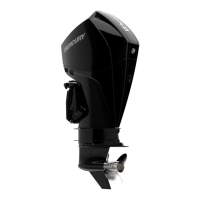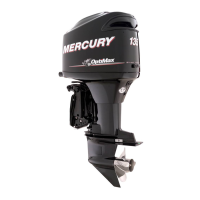Engine Off Test Engine Key On Test Engine Running Test
5.
Record the voltage of the house
battery.
NOTE: The voltage should be
11.5–12.5 V. If voltage is lower
than 11.5 V, charge the battery.
5.
Record the voltage of the engine
battery.
5.
Start the engine and allow it to run at idle
speed.
6.
Record the voltage of the engine
battery.
NOTE: The voltage should be
11.5–12.5 V. If voltage is lower
than 11.5 V, charge the battery.
6.
Record the voltage of the house
battery.
6. Record the voltage of the engine battery.
7.
Check for continuity from all
isolator posts to common boat
ground.
NOTE: Each "output" post should
read the respective battery voltage
and the "input" should read 0.
7.
Trim the engine down and stall the
trim in the down position.
Verify that only the engine battery
has voltage drop.
7.
Record the voltage of the house battery.
NOTE: Voltages should be slightly above
what was noted in the
Engine Key On
Test
. If not, check the voltage on the
input stud. The input stud voltage should
be 13.5 V or higher. If voltage does not
make it "through" the isolator, replace the
isolator.
8.
If voltage is found on the input
stud, replace the isolator.
8.
If voltage drops on both batteries
replace the isolator.
8.
Place the engine in throttle only mode
and increase the engine speed to 1000
RPM.
9.
If no voltage is found on the input
stud, proceed to Engine Key On
Test.
9.
If voltage drops on the engine
battery only, proceed to Engine
Running Test.
9. Record the voltage of the engine battery.
10.
Record the voltage of the house battery.
NOTE: Voltage at both the engine and
house batteries should be higher than
what was recorded in the idle test. If not,
check the voltage on the input stud. The
input stud voltage should be 14.5 V ±
0.5V. If voltage is not making it "through"
the isolator, replace the isolator.
Accessories
Page 5C-10 © 2018 Mercury Marine 90-8M0146617 eng JULY 2018

